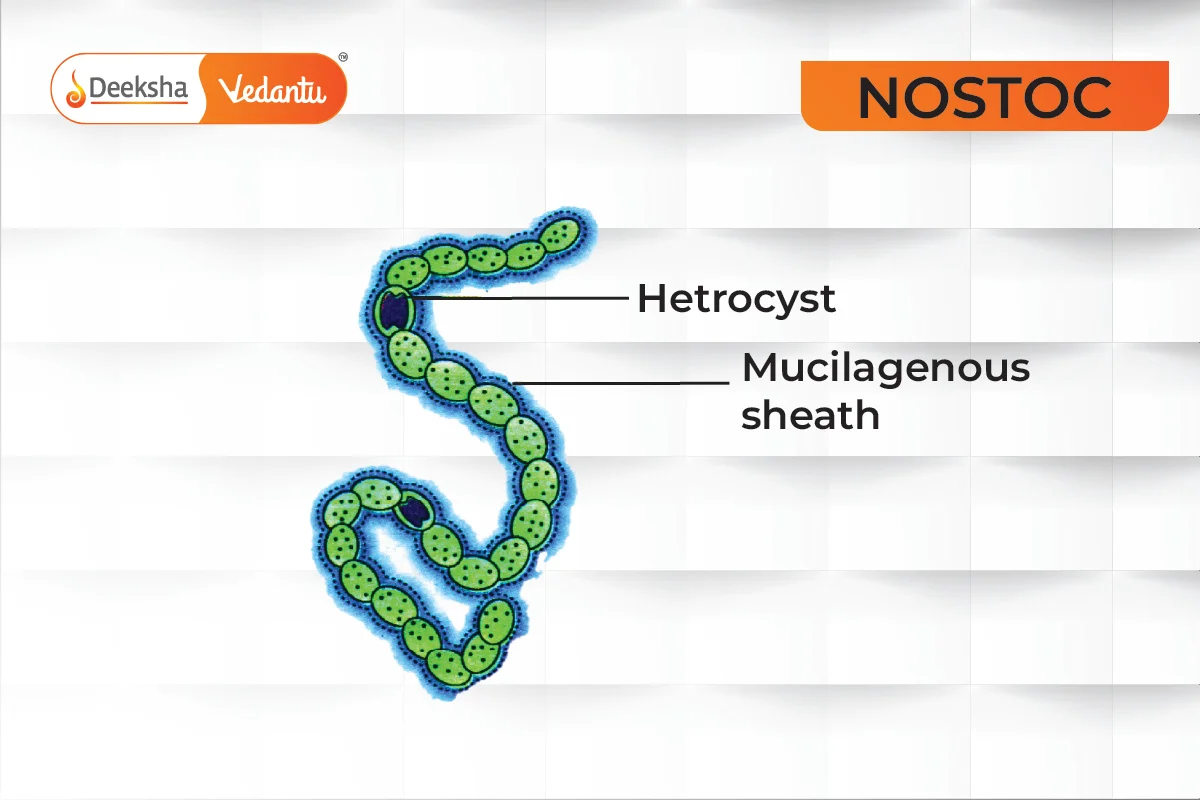Nostoc is a genus of blue-green algae, also known as cyanobacteria. These prokaryotic organisms are capable of photosynthesis and are primarily found in freshwater environments. They can exist as free-living colonies or attached to various surfaces such as rocks, tree trunks, and the bottom of lakes. Nostoc species are also known for their ability to fix nitrogen and form symbiotic relationships with other organisms.

Classification of Nostoc
Nostoc are classified as follows:
- Domain: Bacteria
- Phylum: Cyanobacteria
- Class: Cyanophyceae
- Order: Nostocales
- Family: Nostocaceae
- Genus: Nostoc
Commonly found species include:
- Nostoc commune – Eaten as a salad.
- Nostoc azollae – Forms a symbiotic association with the water fern.
- Nostoc punctiforme – Forms symbiotic relationships with Anthoceros and other higher plants.
- Nostoc flagelliforme – Known as Fat choy, used as a vegetable in China.
- Nostoc pruniforme – Forms very large colonies.
Structure of Nostoc
- Filamentous and Unbranched: Nostoc forms numerous filaments within a gelatinous mass, creating colonies that can be as large as an egg.
- Trichomes: Each filament consists of a chain of cells resembling beads.
- Cell Shape: Cells can be oval, spherical, or cylindrical.
- Heterocysts: Specialized cells that fix nitrogen, containing the enzyme nitrogenase.
- Mucilaginous Sheath: A protective layer made up of polysaccharides and proteins, which absorbs and retains water.
- Colony Color: Colonies vary in shape, size, and color, typically greenish or bluish-green, but can also be red-brown or yellow-green.
- Extracellular Pigments: Pigments like nostocine and scytonemin protect against UV radiation.
- Cell Wall: Thick, made up of peptidoglycan.
- Cytoplasm: Differentiated into an outer chromoplast region and an inner clear region.
- Pigments: Cells contain chlorophyll, phycocyanin, and phycoerythrin.
- DNA: Found in an incipient nucleus without histones.
Reproduction of Nostoc
- Vegetative Reproduction: Occurs through fragmentation. Small colonies grow attached to a larger colony and eventually form separate colonies.
- Hormogonia: Short, free filaments that develop into new trichomes.
- Asexual Reproduction: Through the formation of akinetes (resting spores) which are thick-walled cells that can withstand unfavorable conditions.
- Heterocyst Reproduction: Heterocysts separate from the filament and germinate into new filaments.
Ecological Importance
- Nitrogen Fixation: Nostoc species enrich soil nutrients, especially in paddy fields.
- Nutritional Value: Rich in proteins and vitamin C, used as food in various Asian countries.
- Industrial Applications: N. muscorum can accumulate polyhydroxybutyrate, a precursor of plastic.
- Biofuel Production: Capable of converting CO2 to biofuels, with Nostoc producing hydrogen.
- Bioremediation: Can degrade environmental pollutants and clean wastewater.
- Medical Potential: Extracts from various Nostoc species have shown antibacterial or antiviral properties, useful for drug development.
FAQs
Common species include Nostoc commune, Nostoc azollae, Nostoc punctiforme, Nostoc flagelliforme, and Nostoc pruniforme.
Nostoc can be found in freshwater environments, on tree trunks, rocks, and as symbionts in lichens and certain bryophytes.
Nostoc are important for nitrogen fixation, enriching soil nutrients. They also have potential uses in biofuel production, bioremediation, and the pharmaceutical industry due to their antibacterial and antiviral properties.
Nostoc reproduces vegetatively through fragmentation and asexually by forming akinetes. They also reproduce using heterocysts.
Nostoc is a genus of blue-green algae or cyanobacteria, found mainly in freshwater environments. They are capable of photosynthesis and nitrogen fixation.
Related Topics
- Paramecium
- Types of Fermentation
- Important Notes For NEET Biology – The Living World
- Connective Tissue
- DNA Polymerases
- NEET Biology Weightage
- Epithelial Tissue
- Bryophytes
- Plasma Membrane Structure
- Important Notes For NEET Biology -Shapes of Bacteria
- Important Notes For NEET Biology – Morphology of Flowering Plants
- Important Notes For NEET Biology – Chromosome Structure
- Plant Hormones
- Protozoa
- Important Notes For NEET Biology – Anatomy of Flowering Plants






Get Social